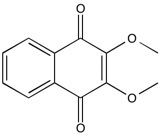DMNQ | Induces ROS generation
\NMR (Conforms)

Available Options
| Size : | Price | Quantity | |
|---|---|---|---|
| 5 mg | $60.00 | ||
| 25 mg | $205.00 |
DMNQ (6956-96-3) is a non-alkylating redox cycling quinone. A useful tool for studying reactive oxidant species and oxidative stress. Cellular effects are dependent on concentration and cell type.
References/Citations
1) Gant et al. (1988) Redox Cycling and Sulphydryl Arylation; Their Relative Importance in the Mechanism of Quinone Cytotoxicity to Isolated Hepatocytes; Chem. Biol. Interactions; 65 157
2) Stubberfield and Cohen (1989) Interconversion of NAD(H) to NADP(H). A cellular response to quinone-induced oxidative stress in isolated hepatocytes; Biochem. Pharmacol., 38 2631
3) Dypbukt et al (1994) Different prooxidant levels stimulate growth, trigger apoptosis or produce necreosis of insulin-secreting RINm5F cells. The role of intracellular polyamines; J. Biol. Chem., 269 30553
4) Henry and Wallace (1996) Differential mechanisms of cell killing by redox cycling and arylating quinones; Arch. Toxicol., 70 482
\NMR (Conforms)
Safety Data Sheet:
Product Data Sheet:
Materials provided by Focus Biomolecules are for laboratory research use only and are not intended for human or veterinary applications. Please note that we do not sell to individuals and that all orders placed by non-research organizations will incur a $20 restocking/refund fee
DMNQ (6956-96-3) is a non-alkylating redox cycling quinone. A useful tool for studying reactive oxidant species and oxidative stress. Cellular effects are dependent on concentration and cell type.
References/Citations
1) Gant et al. (1988) Redox Cycling and Sulphydryl Arylation; Their Relative Importance in the Mechanism of Quinone Cytotoxicity to Isolated Hepatocytes; Chem. Biol. Interactions; 65 157
2) Stubberfield and Cohen (1989) Interconversion of NAD(H) to NADP(H). A cellular response to quinone-induced oxidative stress in isolated hepatocytes; Biochem. Pharmacol., 38 2631
3) Dypbukt et al (1994) Different prooxidant levels stimulate growth, trigger apoptosis or produce necreosis of insulin-secreting RINm5F cells. The role of intracellular polyamines; J. Biol. Chem., 269 30553
4) Henry and Wallace (1996) Differential mechanisms of cell killing by redox cycling and arylating quinones; Arch. Toxicol., 70 482
Calculate the molar concentration, mass or volume in a solution.
Concentration × Volume × Molecular Weight = Mass
Focus Biomolecules • Plymouth Meeting, PA USA • 1-855-FOCUS21
Focus Biomolecules
Plymouth Meeting, PA USA
1-855-FOCUS21
Website Created by Advanta Advertising LLC.

